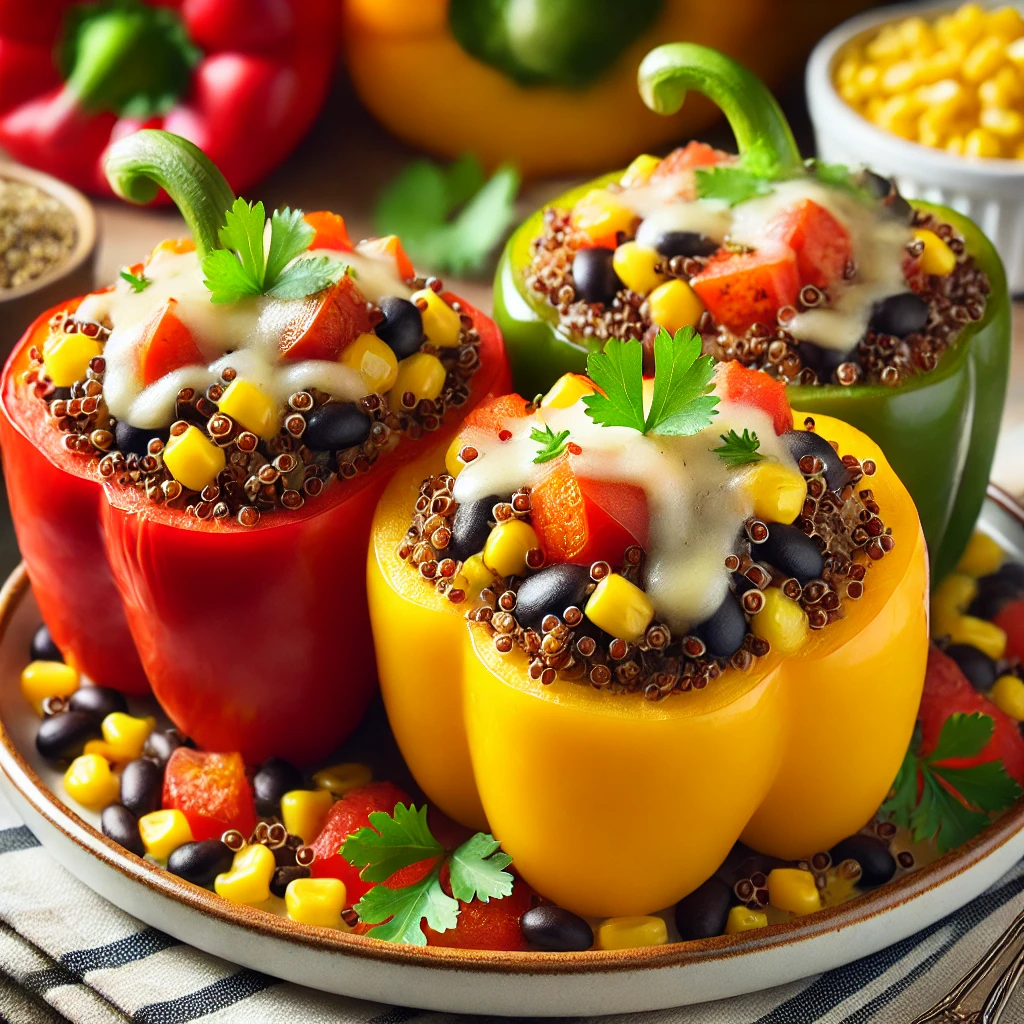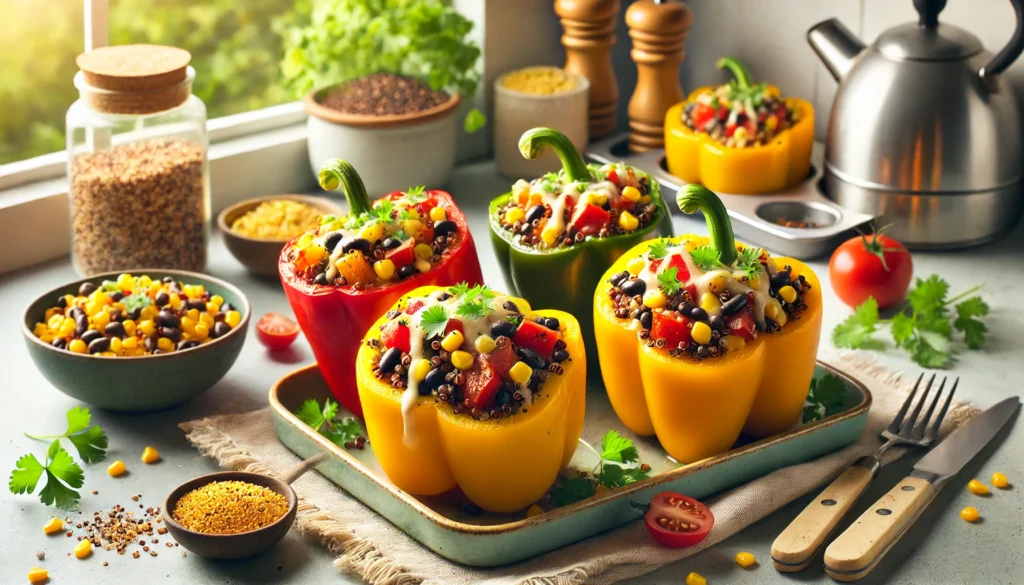Quinoa and Black Bean Stuffed Bell Peppers: My Go-To High-Protein Vegetarian Delight
Let me tell you about one of my absolute favorite recipes that never fails to impress both my taste buds and my nutritional goals: Quinoa and Black Bean Stuffed Bell Peppers.
As someone who’s always on the lookout for high-protein vegetarian dishes, this recipe checks all the boxes—it’s hearty, colorful, nutritious, and most importantly, incredibly delicious.
Why I Love This Recipe
There’s something so satisfying about the combination of flavors and textures in these stuffed bell peppers.
The peppers themselves bring a natural sweetness and a slight crunch that pairs beautifully with the savory, protein-packed filling of quinoa, black beans, and veggies.
Plus, they’re like little edible bowls—what’s not to love about that?
I also appreciate how versatile this recipe is.
You can easily adjust the spices to suit your taste, swap out ingredients based on what you have on hand, or even make it vegan by skipping the cheese or using a plant-based alternative.
It’s the kind of dish that’s perfect for meal prep, impressing guests, or just treating yourself to a wholesome and satisfying meal.
The Health Benefits
As someone who strives to eat healthily, I’m always thrilled when a recipe is as nutritious as it is tasty.

Each stuffed pepper is packed with plant-based protein and fiber, thanks to the quinoa and black beans.
Quinoa is a complete protein, meaning it contains all nine essential amino acids, making it an excellent choice for vegetarians like me who are mindful of their protein intake.
Black beans add an extra boost of protein and fiber, helping to keep me full and energized.
The bell peppers themselves are rich in vitamins A and C, which are great for boosting immunity and keeping skin healthy.
Add in some corn for a touch of sweetness and extra fiber, and you’ve got a dish that’s not just a feast for the eyes, but also a powerhouse of nutrition.
How I Make Them
The process is pretty straightforward, which is another reason why this dish has become a staple in my kitchen. I start by cooking the quinoa, which only takes about 15 minutes. Meanwhile, I prep the peppers by cutting off the tops and scooping out the seeds—this is where the fun starts!
Next, I sauté some onions and garlic until fragrant, then add in the black beans, corn, diced tomatoes, and the cooked quinoa. I season it all with cumin and chili powder, which gives the filling a warm, smoky flavor that I just can’t get enough of.
Stuffing the peppers is the best part. I generously fill each one with the quinoa mixture, packing it in so that every bite is bursting with flavor. If I’m feeling indulgent, I’ll sprinkle some shredded cheese on top, which melts beautifully in the oven and adds a nice creamy finish.
After about 35 minutes in the oven, the peppers are tender, the filling is perfectly cooked, and my kitchen smells absolutely amazing. I like to garnish them with a sprinkle of fresh cilantro for a pop of color and an extra layer of freshness.
A Meal to Share or Savor Alone
These stuffed peppers are perfect for sharing, but I often find myself making a big batch just for me to enjoy throughout the week.
They reheat beautifully and even taste great cold, making them a convenient option for busy days when I need a quick, nutritious meal.
Plus, they’re visually stunning—every time I pull them out of the oven, I feel like I’ve made something really special.
If you’re looking for a delicious, high-protein vegetarian dish that’s as fun to make as it is to eat, I can’t recommend these Quinoa and Black Bean Stuffed Bell Peppers enough.
Whether you’re a seasoned vegetarian or just looking to incorporate more plant-based meals into your diet, this recipe is a winner.
So go ahead, grab some bell peppers, and get stuffing. Your taste buds (and your body) will thank you!
Ingredients:
- 4 large bell peppers (any color), tops cut off and seeds removed
- 1 cup quinoa, rinsed
- 1 can (15 oz) black beans, drained and rinsed
- 1 cup corn kernels (fresh, canned, or frozen)
- 1 medium onion, diced
- 2 cloves garlic, minced
- 1 cup diced tomatoes (canned or fresh)
- 1 teaspoon cumin
- 1 teaspoon chili powder
- Salt and pepper to taste
- 1 cup shredded cheese (optional for a vegetarian option, or use plant-based cheese)
- Fresh cilantro, chopped (for garnish)
- 1 tablespoon olive oil
Instructions:
- Preheat the Oven: Preheat your oven to 375°F (190°C).
- Cook the Quinoa: In a medium pot, bring 2 cups of water to a boil. Add the quinoa, reduce the heat, cover, and simmer for about 15 minutes, or until the quinoa is cooked and the water is absorbed. Fluff with a fork and set aside.
- Sauté Vegetables: In a large skillet, heat olive oil over medium heat. Add diced onion and cook until softened, about 5 minutes. Add the garlic and cook for another minute.
- Mix the Filling: Add the black beans, corn, diced tomatoes, cooked quinoa, cumin, chili powder, salt, and pepper to the skillet. Stir well and cook for another 5 minutes until everything is heated through.
- Stuff the Peppers: Place the bell peppers in a baking dish and fill them with the quinoa and black bean mixture. Top with shredded cheese if using.
- Bake: Cover the dish with aluminum foil and bake for 25 minutes. Remove the foil and bake for an additional 10 minutes, or until the peppers are tender and the cheese is melted and bubbly.
- Garnish and Serve: Garnish with fresh cilantro before serving.
Nutritional Information (Per Stuffed Pepper):
- Calories: 320 kcal
- Protein: 14g
- Carbohydrates: 50g
- Fiber: 12g
- Fat: 8g
- Sugar: 10g
These quinoa and black bean stuffed bell peppers are a delicious and nutritious vegetarian dish packed with protein and fiber. The combination of quinoa, black beans, and vegetables makes this recipe not only high in protein but also rich in vitamins, minerals, and antioxidants.

Nutritional Information (Per Stuffed Pepper):
- Calories: 320 kcal
- Protein: 14g
- Carbohydrates: 50g
- Fiber: 12g
- Fat: 8g
- Sugar: 10g
Disclaimer:
The nutritional information provided is an estimate based on standard ingredient amounts and common brands. Actual values may vary depending on the specific ingredients used, portion sizes, and preparation methods. For precise nutritional details, consider using a nutrition calculator or consult a registered dietitian. Adjust the recipe as needed to meet your individual dietary needs and preferences.

Comments